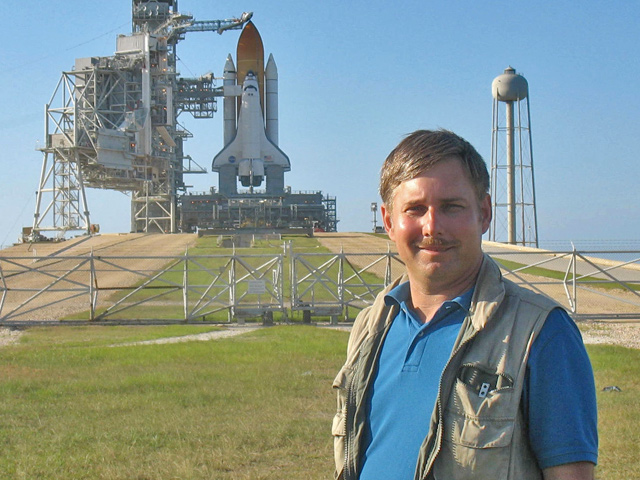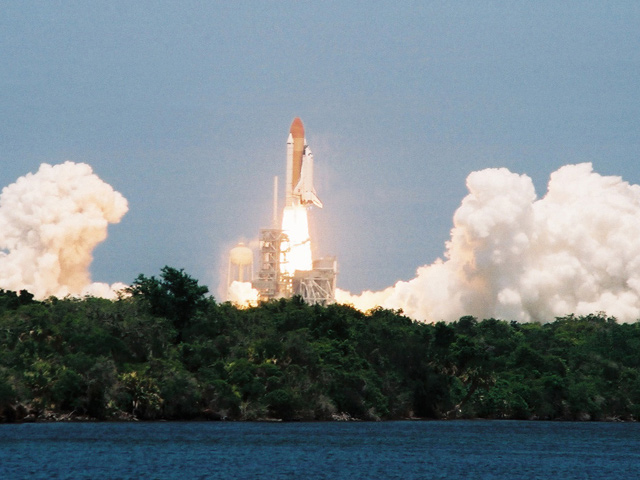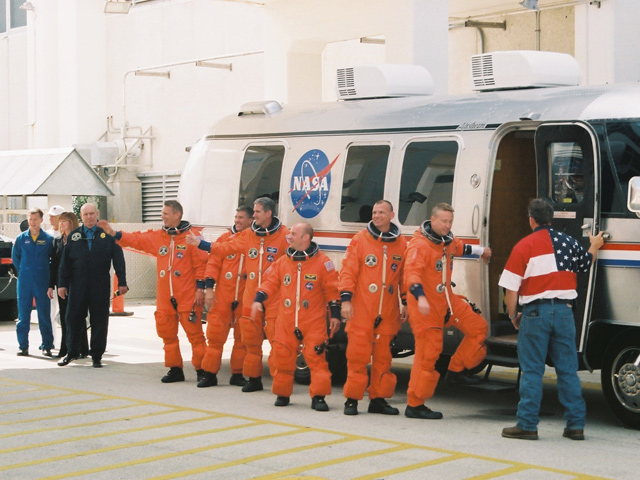From Peter Merlin
On May 14, I sat beside a blue lagoon beneath cloudless skies just three miles from Launch Complex 39A at the Kennedy Space Center in Florida, and felt a growing sense of “launch fever.” It had set in the day before as I stood at the edge of the launch pad – the same from which humans first journeyed to the moon – and watched the Rotating Service Structure roll back to reveal space shuttle Atlantis stacked on its external fuel tank and twin solid-propellant rocket boosters. As I stood there, it occurred to me that river gravel that comprised the roadbed beneath my feet had been crushed by the combined weight of the shuttle stack atop its Mobile Launch Platform and Crawler Transporter, weighing roughly 17 million pounds – the weight of history.

NASA Dryden contract historian/archivist Peter Merlin stands in front of Launch Complex 39A following rollback of the Rotating Service Structure on the evening prior to launch of space shuttle Atlantis for STS-132.
This rare opportunity arose from my work as a contract historian/archivist at NASA Dryden Flight Research Center where I maintain a collection of historical reference material and share Dryden’s accomplishments through various publications, exhibits, and presentations. I was visiting Florida because KSC was selected to host the annual NASA History Division meeting and training event in order to coincide with the launch of shuttle mission STS-132. It was a chance for historians from each of the NASA centers to witness history being made and share in one of the most visible accomplishments of the agency.

With only three remaining missions planned before retirement of the shuttle fleet, STS-132 is the final scheduled flight of Atlantis. Mission commander Ken Ham, however, said his crew jokingly referred it as the “first last flight of Atlantis” because the orbiter will be prepared for a launch-on-need contingency rescue mission should something go wrong with the final scheduled mission, currently slated for November. NASA managers have also discussed the possible addition of another Atlantis mission, STS-135, to fly at end of the shuttle manifest in early- to mid-2011, but this has yet to be approved or funded.
On the morning of the launch, I joined a small crowd of well-wishers to cheer and wave as Ham and his five crewmembers departed the Operations and Checkout Building in their bright orange space suits. “See you in two weeks,” shouted Ham just before boarding the Astrovan, a modified 1983 Airstream Excella motorhome.
Later, by the water’s edge, I sat beside a 10-foot-high digital clock that ticked off the final minutes and seconds to liftoff. Looking around, I saw hundreds of news media representatives, students, and other invited guests, and I knew thousands more waited on the causeway between KSC and Cape Canaveral Air Force Station. It was a marked contrast to when I sat in this same spot nearly 25 years earlier to witness the maiden flight of Atlantis. Since it had been a classified mission for the Department of Defense, guest passes were not issued to the public and even the exact time of liftoff was not announced in advance.
For Atlantis’ swan song, however, NASA made an effort to accommodate as many visitors as possible, including about 150 “tweeters” sending out live electronic updates via Twitter.
During the last few hours of the countdown I met with David Alexander, the Digital Learning Network coordinator for Oklahoma State University’s program at the Aerospace Education Research and Operations, or AERO, Institute in Palmdale, Calif., and a member of the Dryden Education Office. Together, we produced some prelaunch video commentary for possible application to Dryden’s web site or the DLN, an interactive learning program for students and educators that allows students to interact directly with NASA experts, engineers and researchers to gain new appreciation for the importance of science, technology, engineering and mathematics.
Soon, the final seconds of the countdown were upon us. Two white plumes of steam issued from concrete flame trenches at the base of the launch pad as the shuttle’s three main engines fired, instantly evaporating most of the 300,000 gallons of water that had been dumped in just 10 seconds earlier. The spectacle was oddly silent, at first, because it took a while for the sound to reach the viewing area. A flash of orange signaled the ignition of the boosters, each producing 3.3 million pounds of thrust. Liftoff!
A distant crackling sound quickly built to a pulsing roar as Atlantis thundered toward space on twin pillars of fire. The flames were unbelievably bright and seemed to display a rainbow of colors as the vehicle gracefully rotated, ascending toward orbit while arcing away toward the distant horizon. Within a few minutes the vehicle was out of sight and the winds soon dispersed the clouds of smoke and steam rising from the launch pad.
At Dryden I have had the opportunity to witness more than 20 shuttle landings. They have a special grace and beauty but nothing can rival the awesome power of a launch and the opportunity to see humans journey into the frontier beyond our atmosphere that we have only begun to explore.
Peter Merlin of Tybrin Corp. is a historian at NASA’s Dryden Flight Research Center.
